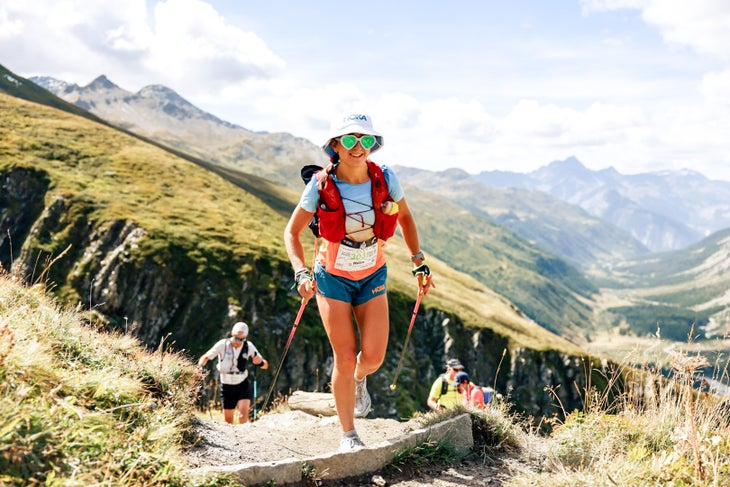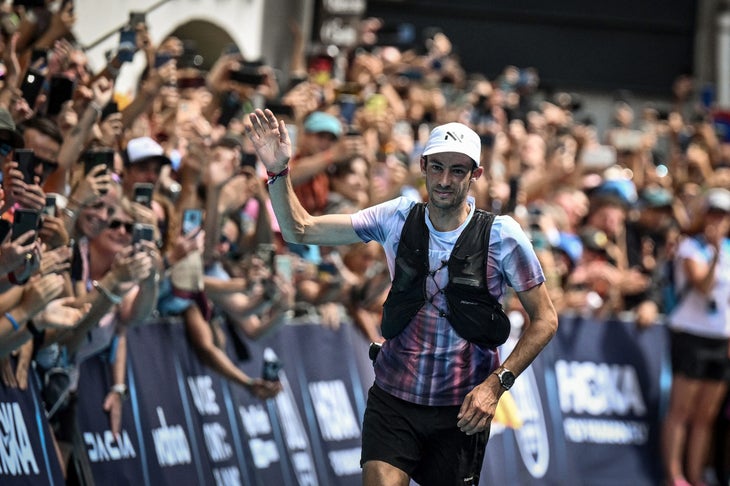“], “filter”: { “nextExceptions”: “img, blockquote, div”, “nextContainsExceptions”: “img, blockquote, a.btn, a.o-button”} }”>
New perk: Easily find new routes and hidden gems, upcoming running events, and more near you. Your weekly Local Running Newsletter has everything you need to lace up!
>”,”name”:”in-content-cta”,”type”:”link”}}”>Subscribe today.
These days, it feels like trail running—and UTMB specifically—cannot be mentioned without the phrase “growing pains.” Well, when UTMB recently announced a new anti-doping program, the response was resoundingly positive. For once.
“Yeah it’s good,” says Kilian Jornet, a four-time UTMB Mont Blanc winner.
In addition to holding the title of most decorated ultra-trail runner of all time, Jornet helped found the Pro Trail Runners Association, a working group of elite ultra-trail runners volunteering their time to better the sport—including through the pursuit of anti-doping regulation. The PTRA worked in conjunction with UTMB to craft this new anti-doping policy.
The UTMB Group, the race organization most famously associated with the eponymous UTMB Mont Blanc 100-miler in Chamonix, France, and now a race series around the world, will be working with the International Testing Agency (ITA) to roll out in-competition testing across the race series, along with updated anti-doping regulations and free online education for elites.
“We are incredibly happy to be working with the team at UTMB and at the ITA to take what is the first of many steps forward when it comes to safe and fair sport in trail and ultrarunning,” the Pro Trail Runners Association wrote on Instagram. “We recognize that in-competition controls are just one of many steps needed, and will continue to work with UTMB and the ITA to carry out athlete, team, and race personnel education. We want to recognize that this is no small feat and commend UTMB for putting up the financial resources to make this first piece of the puzzle possible.”
While this new program is undeniably a step in the right direction, it also illuminates the remaining structural challenges to implementing more systemic anti-doping regulation across a sport that, without a singular global governing body, remains fractured and haphazardly organized.
“It’s been going forward and back and forward and back a bit in the last years,” Jornet says. “The problem with trail running is there isn’t an entity managing everything. So then it’s very hard to have out-of-competition controls.”

Doubling Down on In-Competition Testing
Pledging a minimum investment of 100,000 Euros (or $107,200), UTMB will work in conjunction with the ITA, an independent, non-profit organization that manages anti-doping programs for international federations, major event organizers, and other anti-doping organizations, to administer 100 tests on elites (both on podium finishers and via randomized selection) at UTMB Majors and Finals races through the rest of this year.
This investment in testing comes with a new set of anti-doping regulations that were created in conjunction with the ITA and are in line with the World Anti-Doping Agency (WADA). In addition, UTMB rolled out an education program consisting of free webinars, conducted by ITA experts, to 1,400 elite athletes in the UTMB system.
“As a major player in trail running worldwide, we have a responsibility in the fight against doping in our sport. We take this responsibility very seriously,” says Frédéric Lenart, UTMB Group Managing Director said at the May 21 announcement of the new anti-doping investment. “It’s a further step towards assisting the athletes, providing a solid education program. We are keen to support on this complex subject.”
Because trail running and ultrarunning are not entirely governed by a universal sanctioning body, anti-doping measures have fallen largely on race organizations that have tried to do their part to maintain the integrity of its events. In April, the Western States 100 announced new anti-doping regulations that prohibit entry of suspended runners. Western States also partnered with the United States Anti-Doping Agency (USADA) to provide in-competition testing. (Western States began post-race drug-testing of its competitors in 2017.) The USADA partnership is similar to what Mammoth TrailFest and Pikes Peak Ascent conducted last year after they broke away from the controversial Quartz program connected to the Golden Trail World Series. But those are outlier events. Most trail and ultra races do not implement in-competition testing at all.
UTMB’s increased focus on anti-doping is a direct result of the influx of money, attention, and people flocking to the sport, all of which raise the stakes for performing well—and hence the incentives to cheat. (UTMB is about to announce it’s increasing prize money to 20,000 Euros for the women’s and men’s winners at UTMB Mont Blanc, and 13,000 Euros for each of the winners at CCC and OCC.) Many ultra-trail coaches, athletes, and race officials share the belief that more athletes would get caught using performance enhancing substances (PEDs) if there was more systematic and thorough testing.
RELATED: Trail Running and Drug-Testing: Where Do We Go From Here?
A Step In the Right Direction

This new policy comes on the heels of the suspension of Norwegian runner Stian Angermund, the reigning world mountain running short course champion, who announced that he tested positive for the banned substance chlorthalidone after winning the OCC 53K at the UTMB Finals last summer. Chlorthalidone is a diuretic most commonly used as a masking agent for other performance-enhancing substances. Last year, in-competition testing at UTMB Mont Blanc was conducted by the French Anti-Doping Agency, and it was this national governing body that alerted Angermund of his positive test on October 20, 2023. Angermund steadfastly maintains his innocence amid a pending investigation.
“I’m utterly bewildered. I haven’t used any medications or supplements, nor have I ever taken or misused drugs,” Angermund told the Norwegian media outlet NRK in a video interview published on February 9, 2024. “Where could this possibly have come from? I am a clean athlete.”
The French Anti-Doping agency has suspended Angermund from all competition. He is appealing his case. While Angermund maintains he did not knowingly ingest chlorthalidone, notably, chlorthalidone is not banned by Anti-Doping Norway, the official Norwegen anti-doping association.
Last year was the first time UTMB turned to national anti-doping governing bodies to conduct in-competition testing. Before that, and before UTMB transformed into a global race series, UTMB Mont Blanc—along with other high-profile trail races and series like the Golden Trail World Series—used the Quartz program.
Touted as an “athlete wellness” program rather than an anti-doping one, Quartz has been heavily criticized for its overregulation of athletes without providing sound anti-doping regulation. Under Quartz, which was founded in 2008, athletes vying for prize money and top podium spots were required to submit a pre-race blood test for review and to collate a “biological passport,” along with a post-race blood test.
While the list of banned substances under Quartz includes everything on the World Anti-Doping Association (WADA) list, it also includes WADA-compliant substances including all painkillers, CBD, non-steroidal anti-inflammatories (NSAIDs), such as aspirin and ibuprofen, and therapeutic use exemptions (TUEs), such as inhalers for asthma. Many athletes and coaches voiced a concern that these additional bans were not scientifically backed, created an unequal playing field, and in fact hurt athlete welfare more than it helped.
Under Quartz, athletes whose results violate any of the banned substances may receive a ban or suspension. And indeed, numerous athletes tested positive for banned substances under Quartz, including Esther Chesang and Mark Kangogo, the women’s and men’s winners of the 2022 Sierre-Zinal, a Golden Trail World Series Race. (Chesang tested positive for triamcinolone acetonide, an anti-inflammatory steroid banned by WADA. Kangogo was suspended for four years by the Athletics Integrity Unit after testing positive for two prohibited substances, triamcinolone acetonide and norandrosterone, an anabolic steroid used to promote tissue and skeletal repair. Both positive tests came from in-competition tests that year.)
Maud Mathys (Switzerland), Elisa Desco (Italy), Petro Mamu (Eritrea), Christel Dewalle (France), and Gonzalo Calisto (Ecuador) are among the elite trail-ultra runners who have either been suspended or reprimanded after testing positive for performance-enhancing drugs on WADA’s list of banned substances in recent years.
Yet Quartz officials maintain that doping regulation is not their primary purpose.
“Doping doesn’t concern us,” said Pierre Sallet, a representative from the Athletes for Transparency Association, which runs Quartz, after Kangogo’s ban was announced. “What we are interested in are the medical risks, such as thrombosis or serious kidney failure. Our mission is not to catch those who cheat—although we are pleased to help make the sport fair—it’s to talk about health issues with the athletes and protect them when they aren’t able to do it themselves.”
Remaining Challenges
From a high-level view, UTMB should be acknowledged for its efforts here. While there’s still more it can do (out-of-competition testing, expand testing to high-performing age-groupers), as a race organization there’s only so much it can control, and it is trying to take the reins.
“It’s good,” says Jornet of the new policy. “But people are testing positive in another sport and then coming over, and I think that’s the problem. And that’s what we’re trying to solve.”
While in-competition testing is absolutely vital to furthering clean sport efforts, it’s one piece of a vast and unregulated puzzle. Unlike even track and field or road marathoning, which sit under the purview of World Athletics and implement a comprehensive in and out-of-competition testing program run by WADA, trail/ultra/mountain running are not regulated by a universal governing body. This lack of unified regulation makes it impossible for the sport to implement the type of systematic testing needed to reach a gold standard.
Some national governing bodies test trail and ultrarunners, but many do not. And given the highly sophisticated nature of doping, athletes can time their doping dosing to avoid positive tests at races—something that’s been happening in track and field, triathlon, and marathon running for years.

In addition, in this wild west environment, athletes who get suspended or banned from WADA-regulated sports like track and field, road running, or even cycling or triathlon can transition to trail running and compete with much less concern about getting tested.
You often hear the argument within the trail running community that there’s no way trail runners can be doping; they’re “too nice” or the sport has too much of a wholesome, grassroots vibe. But that’s a red herring argument, given the range of personalities that have been caught cheating. In addition, as the sport continues to professionalize and with more money coming into the sport every year, the incentives to cheat will seemingly only increase.
Hillary Allen, a professional ultrarunner for Brooks who took second at the 2019 TDS, a UTMB Finals race, agrees with Jornet that the new UTMB policy is good. But like Jornet, she says it’s a “yes, and” situation.
“I think it’s a good thing,” she says of the new policy. “However, I think there’s a misunderstanding and I think a lot of athletes are going to be caught off guard because they don’t really know what it is. And I think it’s incomplete because there’s no clear direction on who will be tested.”
Like Jornet, Allen also flags the dangers of focusing solely on in-competition testing.
“I think in order for it to actually be preventative, it needs to be year-round and athletes need to be signed up into an anti-doping pool,” she says.
Even sports with international governing bodies whose drug testing programs are overseen by WADA, like swimming, face significant barriers to catching—and preventing—cheating. In April, the New York Times broke the news that 23 elite Chinese swimmers had tested positive for the banned substance trimetazidine (TMZ), a prescription heart drug that pumps more blood (and hence oxygen) into your heart. Chinese anti-doping officials secretly cleared their names, WADA chose not to intervene, and they competed at the Tokyo Olympics seven months later. Three won Olympic gold medals.
“It’s hard going into Paris knowing that we’re going to be racing some of these athletes,” said Katie Ledecky, a seven-time Olympic gold medalist swimmer from the U.S who will be competing at the Paris Olympics. “And I think our faith in some of the systems is at an all-time low.”
RELATED: More Prize Money Is Flowing Into Trail Running. What Does That Mean for the Sport?
What’s Next?
It would seem that the key to implementing a systematic anti-doping program across not only UTMB, but trail-ultra running at large that provides systematic in and out-of-competition testing would be to have it organized by a universal governing body. Easier said than done.
Ultimately, the sport might fall under World Athletics, the international governing body of competitive running, but so far World Athletics hasn’t shown much interest or ability to take on that challenge. (However, World Athletics has gotten behind the combined World Mountain and Trail Running Championships that were held in 2022 and 2023 and will be held again in 2025 in Canfranc-Pirineos, Spain.)
“In 2011, we tried,” Jornet says. “The thing is, the sport is just so fractured, and that makes it very hard to make everyone totally in sync. I’m hopeful that the PTRA can be like a glue in between parts. But I don’t think creating another federation will help, because it will be fragmenting it even more.”
Jornet cites how the sport triathlon contains both Ironman and the Professional Triathletes Association, which govern two long course triathlon race series, and the International Triathlon Union, which oversees short course triathlon, like you see in the Olympics. Even with this fractured system, the sport manages to implement a comprehensive anti-doping program overseen by WADA.
“It can be fragmented if it’s organized together,” Jornet says. “How I see trail running, with the different distances and terrains, I see it can be different federations or private entities, but hopefully somehow it’s under an umbrella that meets our standards.”
RELATED: Why the Fight Against Doping Is Tedious But Necessary
